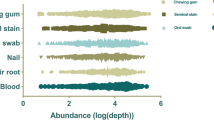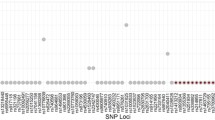Abstract
Massively parallel sequencing (MPS) offers substantial improvements over current forensic DNA typing methodologies such as increased resolution, scalability, and throughput. The Ion PGM™ is a promising MPS platform for analysis of forensic biological evidence. The system employs a sequencing-by-synthesis chemistry on a semiconductor chip that measures a pH change due to the release of hydrogen ions as nucleotides are incorporated into the growing DNA strands. However, implementation of MPS into forensic laboratories requires a robust chemistry. Ion Torrent’s Hi-Q™ Sequencing Chemistry was evaluated to determine if it could improve on the quality of the generated sequence data in association with selected genetic marker targets. The whole mitochondrial genome and the HID-Ion STR 10-plex panel were sequenced on the Ion PGM™ system with the Ion PGM™ Sequencing 400 Kit and the Ion PGM™ Hi-Q™ Sequencing Kit. Concordance, coverage, strand balance, noise, and deletion ratios were assessed in evaluating the performance of the Ion PGM™ Hi-Q™ Sequencing Kit. The results indicate that reliable, accurate data are generated and that sequencing through homopolymeric regions can be improved with the use of Ion Torrent’s Hi-Q™ Sequencing Chemistry. Overall, the quality of the generated sequencing data supports the potential for use of the Ion PGM™ in forensic genetic laboratories.







Similar content being viewed by others

References
Metzker ML (2010) Sequencing technologies—the next generation. Nat Rev Genet 11:31–46
Borsting C, Morling N (2015) Next generation sequencing and its applications in forensic genetics. Forensic Sci Int Genet 18:78–89
Churchill JD, Schmedes SE, King JL, Budowle B (2016) Evaluation of the Illumina Beta Version ForenSeq™ DNA signature. Forensic Sci Int Genet 20:20–29
Warshauer DH, Churchill JD, Novroski N, King JL, Budowle B (2015) Novel Y-chromosome short tandem repeat variants detected through the use of massively parallel sequencing. Genomics Proteomics Bioinformatics 13:250–257
Gettings KB, Aponte RA, Vallone PM, Butler JM (2015) STR allele sequence variation: current knowledge and future issues. Forensic Sci Int Genet 18:118–130
Gettings KB, Kiesler KM, Faith SA, Montano E, Baker CH, Young BA, Guerrieri RA, Vallone PM (2016) Sequence variation of 22 autosomal STR loci detected by next generation sequencing. Forensic Sci Int Genet 21:15–21
Fordyce SL, Mogensen HS, Borsting C, Lagacé RE, Chang CW, Rajagopalan N, Morling N (2015) Second-generation sequencing of forensic STRs using the Ion Torrent™ HID STR 10-plex and the Ion PGM™. Forensic Sci Int Genet 14:132–140
Churchill JD, Chang J, Ge J, Rajagopalan N, Wootton SC, Chang CW, Lagace R, Liao W, King JL, Budowle B (2015) Blind study evaluation illustrates utility of the ion PGM™ system for use in human identity DNA typing. Croat Med J 56:218–229
Zhao X, Ma K, Li H, Cao Y, Liu W, Zhou H, Ping Y (2015) Multiplex Y-STRs analysis using the ion torrent personal genome machine (PGM). Forensic Sci Int Genet 19:192–196
Zeng Z, King J, Hermanson S, Patel J, Storts DR, Budowle B (2015) An evaluation of the PwerSeq™ auto system: a multiplex short tandem repeat marker kit compatible with massively parallel sequencing. Forensic Sci Int Genet 19:172–179
King JL, LaRue BL, Novroski NM, Stoljarova M, Seo SB, Zeng X, Warchauer DH, Davis CP, Parson W, Sajantila A, Budowle B (2014) High-quality and high-throughput massively parallel sequencing of the human mitochondrial genome using the Illumina MiSeq. Forensic Sci Int Genet 12:128–135
Parson W, Strobl C, Huber G, Zimmermann B, Gomes SM, Souto L, Fendt L, Delport R, Langit R, Wootton S, Lagace R, Irwin J (2013) Evaluation of next generation mtGenome sequencing using the Ion Torrent Personal Genome Machine (PGM). Forensic Sci Int Genet 7:632–639
Borsting C, Fordyce SL, Olofsson J, Mogensen HS, Morling N (2014) Evaluation of the Ion Torrent™ HID SNP 169-plex: a SNP typing assay developed for human identification by second generation sequencing. Forensic Sci Int Genet 12:144–154
Just RS, Irwin JA, Parson W (2015) Mitochondrial DNA heteroplasmy in the emerging field of massively parallel sequencing. Forensic Sci Int Genet 18:131–139
Rothberg JM, Hinz W, Rearick TM, Schultz J, Mileski W, Davey M et al (2011) An integrated semiconductor device enabling non-optical genome sequencing. Nature 475:348–352
Loman NJ, Misra RV, Dallman TJ, Constantinidou C, Gharbia SE, Wain J, Pallen MJ (2012) Performance comparison of benchtop high-throughput sequencing platforms. Nat Biotechnol 30:434–439
Bragg LM, Stone G, Butler MK, Hugenholtz P, Tyson GW (2013) Shining a light on dark sequencing: characterising errors in ion torrent PGM data. PLoS Comput Biol 9:e1003031
Seo SB, Zeng X, King JL, Larue BL, Assidi M, Al-Qahtani MH, Sajantila A, Budowle B (2015) Underlying data for sequencing the mitochondrial genome with the massively parallel sequencing platform Ion Torrent™ PGM™. BMC Genomics 16(Suppl 1):S4
Bottino CG, Chang CW, Wootton S, Rajagopalan N, Langit R, Lagace RE, Silva R, Moura-Neta RS (2015) STR genotyping using ion torrent PGM and STR 24-plex system: performance and data interpretation. Forensic Sci Int Genet 5:e325–e326
Eduardoff M, Santos C, de la Puente M, Gross TE, Fondevila M, Strobl C, Sobrino B, Ballard D, Schneider PM, Carracedo A, Lareu MV, Parson W, Phillips C (2015) Inter-laboratory evaluation of SNP-based forensic identification by massively parallel sequencing using the Ion PGM™. Forensic Sci Int Genet 17:110–121
Seo SB, King JL, Warshauer DH, Davis CP, Ge J, Budowle B (2013) Single nucleotide polymorphism typing with massively parallel sequencing for human identification. Int J Legal Med 127:1079–1086
Qiagen (2012) QIAamp® DNA mini and blood mini handbook. Qiagen, Valencia
Thermo Fisher Scientific (2013) Ion PGM™ sequencing 400 kit. Thermo Fisher Scientific, Waltham
Thermo Fisher Scientific (2014) Ion PGM™ Hi-Q™ sequencing kit. Thermo Fisher Scientific, Waltham
Gunnarsdóttir ED, Li M, Bauchet M, Finstermeier K, Stoneking M (2011) High throughput sequencing of complete human mtDNA genomes from the Philippines. Genome Res 21:1–11
Andrews RM, Kubacka I, Chinnery PF, Lightowlers RN, Turnbull DM, Howell N (1999) Reanalysis and revision of the Cambridge reference sequence for human mitochondrial DNA. Nat Genet 23:147
Thorvaldsdóttir H, Robinson JT, Mesirov JP (2013) Integrative Genomics Viewer (IGV): high-performance genomics data visualization and exploration. Brief Bioinform 14:178–192
Robinson JT, Thorvaldsdóttir H, Winckler W, Guttman M, Lander ES, Getz G, Mesirov JP (2011) Integrative genomics viewer. Nat Biotechnol 29:24–26
King JL, Sajantila A, Budowle B (2014) mitoSAVE: mitochondrial sequence analysis of variants in Excel. Forensic Sci Int Genet 12:122–125
Warshauer DH, King JL, Budowle B (2015) STRait Razor v2.0: the improved STR allele identification tool—Razor. Forensic Sci Int Genet 14:182–186
Warshauer DH, Lin D, Hari K, Jain R, Davis C, Larue B, King JL, Budowle B (2013) STRait Razor: a length-based forensic STR allele-calling tool for use with second generation sequencing data. Forensic Sci Int Genet 7:409–417
Thermo Fisher Scientific (2015) GlobalFiler™ PCR amplification kit. Thermo Fisher Scientific, Waltham
Snedecor GW, Cochran WG (1967) Statistical methods, 6th edn. Iowa Univ Press, Ames, pp 95–98
Bertolini F, Ghionda MC, D’Alessandro E, Geraci C, Chiofalo V, Fontanesi L (2015) A next generation semiconductor based sequencing approach for the identification of meat species in DNA mixtures. PLoS ONE 10, e0121701
Scientific Working Group on DNA Analysis Methods [SWGDAM] (2013) Interpretation guidelines for mitochondrial DNA analysis by Forensic DNA Testing Laboratories. http://swgdam.org/SWGDAM%20mtDNA_Interpretation_Guidelines_APPROVED_073013.pdf
Acknowledgments
We thank Thermo Fisher Scientific for providing reagents necessary to complete this study and Robert Lagace, Joseph Chang, Sharon Wootton, and Chien-Wei Chang, specifically, for their necessary technical expertise. We also thank Monika Stoljarova for her technical expertise and work in developing background knowledge over the potential causes of noise seen when sequencing the mitochondrial genome with MPS.
Author information
Authors and Affiliations
Corresponding author
Ethics declarations
Conflict of interest
The authors declare that they have no conflict of interest.
Electronic supplementary material
Below is the link to the electronic supplementary material.
Supplementary Figure 1
Average strand balance across the mitochondrial genome (N = 31) for the Ion PGM™ Sequencing 400 Kit (A) and for the Ion PGM™ Hi-Q™ Sequencing Kit (B) (XLSM 31158 kb).
Supplementary Table 1
Nucleotide positions where the percentage of reads attributed to noise was at or above five percent for either sequencing kit.
Supplementary Table 2
Homology between primer, reference sequence, and read attributed to noise.
Supplementary Table 3
Sequence of the multiple types of noise found between nucleotide positions 13,983 and 13,987.
Supplementary Table 4
Nucleotide positions across entire mitochondrial genome with false deletions.
Rights and permissions
About this article
Cite this article
Churchill, J.D., King, J.L., Chakraborty, R. et al. Effects of the Ion PGM™ Hi-Q™ sequencing chemistry on sequence data quality. Int J Legal Med 130, 1169–1180 (2016). https://doi.org/10.1007/s00414-016-1355-y
Received:
Accepted:
Published:
Issue Date:
DOI: https://doi.org/10.1007/s00414-016-1355-y



